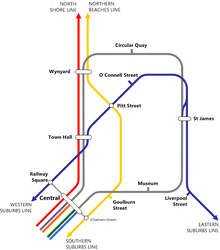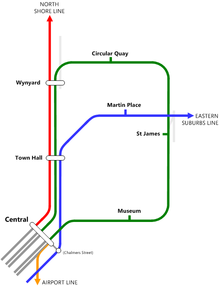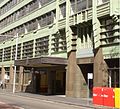- City Circle
-
City Circle 



Mode Commuter Rail Owner CityRail Operator(s) CityRail Connects Central, Town Hall, Wynyard, Circular Quay, St James, Museum Stations 6 Line colour Light Blue, Purple, Green, Orange Key dates 1926 St James & Museum opened 1932 Town Hall & Wynyard opened 1956 Circular Quay opened The City Circle is a system of largely underground passenger railway lines located in the central business district of Sydney, New South Wales, Australia, that make up the heart of the Sydney passenger railway network. The lines are owned by RailCorp, a New South Wales government agency, and operated under RailCorp's CityRail brand. Despite its name, the City Circle is actually a horseshoe shape, with trains operating in a U-shaped pattern. The constituent stations of the Circle are (clockwise): Central, Town Hall, Wynyard, Circular Quay, St James, Museum and back to Central.
Contents
History & description
The original concept for the City Railway was part of a report dated 1915 submitted to the government by John Bradfield upon his return from overseas study,[1] with work commencing the following year.
The City Circle was built in stages. The first stations to open were St. James and Museum, in 1926, as part of the initial electrification of Sydney railways. Next was the "western limb" through Town Hall and Wynyard, which opened in 1932, in conjunction with the opening of the Sydney Harbour Bridge. This section contains four tunnels. Two connected to the Harbour Bridge, while the two City Circle tunnels terminated at Wynyard. In 1956 the dead ends at St. James and Wynyard were joined and the "missing link" - Circular Quay - was opened. Central and Circular Quay are above-ground stations (Circular Quay is elevated, directly underneath the Cahill Expressway), while the remainder are below ground. Several unused railway tunnels also exist. The former tram tunnels at Wynyard, and other stub tunnels at St James are well known.
Services and operations
Current service patterns generally consist of trains from the South and Inner West lines operating around the City Circle in a clockwise manner via Town Hall station and proceed onto the Airport & East Hills, and Bankstown lines. This track is known as the "City Outer". Trains from the Airport & East Hills and Bankstown lines generally operate around the City Circle in an anti-clockwise manner via Museum station and proceed onto the South and Inner West lines (using the "City Inner" track). A set of flying junctions at Central enable this pattern to be varied.
Prior to the integration of the Eastern Suburbs line into the Illawarra Line in 1980, Illawarra line trains also operated around the City Circle.
Trains on the Western and Northern lines usually do not proceed around the City Circle but instead proceed across the Harbour Bridge to the North Shore line and vice versa. Due to weekend trackwork, trains from the City Circle will go to Blacktown or Hurstville.
In 2005, when CityRail completed its most recent estimate of station boardings, the City Circle accounted for 221,160 weekday entries and exits, equivalent to over 55 million annual trips.[2]
It operates a service- every 3 to 5 minutes during peak hours, 6 minutes at other times and 8 to 10 minutes on weekends.
Gallery
References
- ^ 50 Years - A Long Time Wylie, R.F. Australian Railway Historical Society Bulletin, June, 1971 pp140-143
- ^ Region 9 Ministry of Transport Retrieved 2008-08-06
External links
Major public transport services in Greater Sydney Commuter rail
(CityRail)Airport & East Hills Line · Bankstown Line · Carlingford Line · Cumberland Line · Eastern Suburbs & Illawarra Line · Inner West Line · North Shore Line · Northern Line · Olympic Park Line · South Line · Western Line
Under planning: North West Rail Link · Parramatta to Epping Rail Link
Under construction: South West Rail LinkRegional rail Blue Mountains Line · Hunter Line · Newcastle & Central Coast Line · South Coast Line · Southern Highlands LineCommuter bus
(Buses in Sydney)Regional bus Ferry Berowra Waters · Dangar Island · Eastern Suburbs · Inner Harbour · Lower Portland · Lane Cove River · Manly · Mortlake · Parramatta River · Pittwater (ex Church Point) · Pittwater (ex Palm Beach) · Port Hacking · Sackville · Taronga Zoo · Webbs Creek · WisemansOther Railway Lines in New South Wales 
Main lines Broken Hill Line · Main North Line · Main South Line · Main West Line · North Coast Line · South Coast Line
Country branch lines Berrima Line • Binnaway-Werris Creek Line • Blayney-Demondrille Line • Boggabilla Branch • Bombala Line • Canberra Branch • Cobar Branch • Coonamble Branch • Grenfell Branch • Gwabegar Line • Hay Branch • Lake Cargelligo Branch • Medway Quarry Branch • Mungindi Line • Naradhan Branch • Newcastle branch • Oaklands Branch • Parkes to Narromine Line • Picton - Mittagong loop • Pokataroo Branch • Sandy Hollow - Gulgong Line • South Maitland Railway • Stockinbingal - Parkes Line • Temora to Roto Line • Tottenham Branch • Troy Junction - Merrygoen Line • Unanderra - Moss Vale Line • Walgett Branch • Warren Branch • Yanco - Griffith Line
Closed: Ballina line • Barraba line • Belmont line • Boorowa branch • Brewarrina Line • Burcher Branch • Camden Branch • Captains Flat Branch • Corowa Branch • Crookwell line • Dorrigo Line • Eugowra branch • Holbrook Branch • Kunama (Batlow) Branch • Kywong Branch • Merriwa line • Molong to Dubbo line • Morpeth line • Mount Hope line • Murwillumbah Branch • Newnes line • Oberon Line • Rand Branch • Rankins Springs Branch • Richmond Vale Railway • Taralga Branch • Tocumwal line • Toronto Line • Tumbarumba Line • Tumut Branch •Wallsend Branch • Westby Branch
Sydney lines Main Suburban Line • City Circle
Airport Line • Bankstown Line • Carlingford Line • Cumberland Line • Cronulla Line • Eastern Suburbs Line • East Hills Line • Epping to Chatswood Line • Illawarra Line • Inner West Line • North Shore Line • Northern Line • Olympic Park Line • Richmond Line • South Line • Western Line
Goods only: Metropolitan Goods Line • Southern Sydney Freight Line
Closed: Camden Line • Kurrajong Line • Rogans Hill Line • Ropes Creek Line • Royal National Park Line • Sandown Line
Interurban and regional passenger services Blue Mountains Line • Hunter Lines • Newcastle & Central Coast Line • South Coast Line • Southern Highlands Line
Proposed or under construction Tourist & heritage railways Glenreagh Mountain Railway • Lachlan Valley Railway • Richmond Vale Railway • Skitube • Zig Zag Railway
Categories:- CityRail
- Transport in Sydney
- Railway lines in Sydney
- Railway tunnels in Australia
- Railway loop lines
- Standard gauge railways in Australia
Wikimedia Foundation. 2010.









